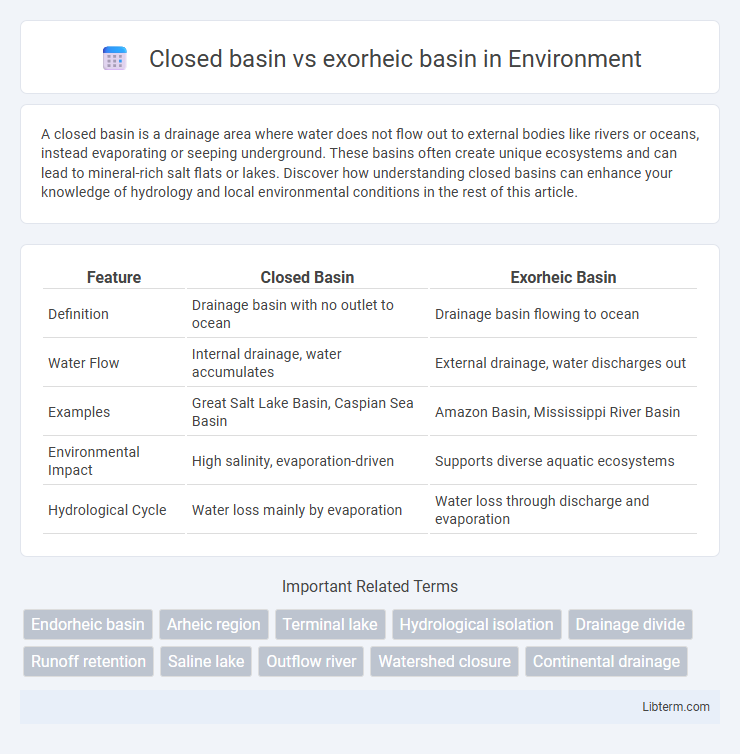A closed basin is a drainage area where water does not flow out to external bodies like rivers or oceans, instead evaporating or seeping underground. These basins often create unique ecosystems and can lead to mineral-rich salt flats or lakes. Discover how understanding closed basins can enhance your knowledge of hydrology and local environmental conditions in the rest of this article.
Table of Comparison
| Feature | Closed Basin | Exorheic Basin |
|---|---|---|
| Definition | Drainage basin with no outlet to ocean | Drainage basin flowing to ocean |
| Water Flow | Internal drainage, water accumulates | External drainage, water discharges out |
| Examples | Great Salt Lake Basin, Caspian Sea Basin | Amazon Basin, Mississippi River Basin |
| Environmental Impact | High salinity, evaporation-driven | Supports diverse aquatic ecosystems |
| Hydrological Cycle | Water loss mainly by evaporation | Water loss through discharge and evaporation |
Introduction to Basin Types
Closed basins, also known as endorheic basins, are drainage areas where water does not flow out to external bodies such as oceans, resulting in internal drainage and sediment accumulation. Exorheic basins feature external drainage systems with rivers and streams that discharge water into seas or oceans, supporting active hydrological cycles. Understanding the hydrological and geomorphological distinctions between closed and exorheic basins is essential for water resource management and ecosystem studies.
Definition of Closed Basins
Closed basins, also known as endorheic basins, are drainage areas where water does not flow out to the ocean but accumulates in lakes or evaporates, lacking external drainage outlets. These basins are characterized by internal water balance, often leading to high salinity and unique ecological conditions. Examples include the Caspian Sea basin and the Great Salt Lake basin, highlighting their significance in hydrology and environmental studies.
Definition of Exorheic Basins
Exorheic basins are drainage basins where surface water flows out through rivers into the sea or ocean, facilitating continuous water discharge and sediment transport. These basins contrast with closed basins, which retain water internally, lacking outflow to external bodies, often leading to salt accumulation in lakes or wetlands. The definition of exorheic basins centers on their open drainage system that connects terrestrial runoff to marine environments, playing a crucial role in global hydrological cycles.
Key Differences Between Closed and Exorheic Basins
Closed basins, also known as endorheic basins, retain water without any outlet to the ocean, causing accumulation of salts and formation of salt lakes or playas. Exorheic basins possess drainage systems that channel water to the sea, ensuring continuous river flow and sediment transport. The hydrological contrast influences ecosystem types, sediment deposition, and water quality, marking the primary distinction between these basin types.
Hydrological Processes in Closed Basins
Closed basins, also known as endorheic basins, lack surface outflow to external bodies of water, causing all precipitation and runoff to accumulate internally, often forming lakes or salt flats. Hydrological processes in closed basins involve water balance controlled primarily by evaporation and infiltration, leading to high salinity levels due to mineral concentration from evaporative loss. In contrast, exorheic basins have integrated drainage systems that transport water to oceans, facilitating continuous water discharge and solute export.
Water Flow Characteristics in Exorheic Basins
Exorheic basins feature water flow that drains externally into oceans or seas, maintaining dynamic river systems with continuous discharge. These basins support extensive drainage networks and groundwater recharge, contributing to sustained hydrological cycles. Flow characteristics in exorheic basins promote sediment transport, nutrient distribution, and ecosystem connectivity across large geographic areas.
Environmental Significance of Basin Types
Closed basins, also known as endorheic basins, retain water without outflow to external bodies like oceans, leading to high salinity and unique ecosystems adapted to arid or semi-arid conditions. Exorheic basins facilitate continuous drainage to oceans or seas, supporting dynamic aquatic habitats, nutrient cycling, and sediment transport critical for biodiversity and human activities. Understanding the environmental significance of these basin types aids in water resource management, ecosystem conservation, and mitigating the impacts of climate change on regional hydrology.
Global Examples of Closed and Exorheic Basins
The Caspian Sea and the Great Salt Lake exemplify closed basins, where water does not drain into the ocean, resulting in high salinity and unique ecological systems. In contrast, the Amazon River Basin and the Mississippi River Basin are prominent exorheic basins, characterized by continuous water flow that drains into the ocean, supporting vast biodiversity and extensive watershed networks. These global examples highlight the hydrological and ecological differences between closed and exorheic basins, crucial for water resource management and environmental studies.
Challenges and Conservation Issues
Closed basins, characterized by internal drainage with no outflow to external bodies of water, face significant challenges such as salinization, water scarcity, and habitat degradation due to limited water exchange and pollution accumulation. Exorheic basins, with external drainage to oceans or seas, experience challenges related to upstream pollution, sedimentation, and water over-extraction that impact downstream ecosystems and water quality. Conservation efforts in closed basins require managing water balance and preventing salinity increases, while exorheic basin conservation focuses on maintaining river connectivity, controlling pollution sources, and sustainable water resource management.
Conclusion: Impacts of Basin Classification
Closed basins limit water outflow, causing higher salinity and unique ecosystems, while exorheic basins support continuous river discharge to oceans, enhancing nutrient cycling and biodiversity. The classification affects water resource management, ecological stability, and sediment transport dynamics. Understanding basin type is crucial for predicting environmental responses to climate change and human activities.
Closed basin Infographic

 libterm.com
libterm.com